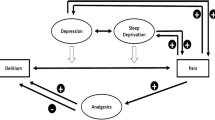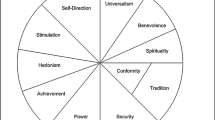Abstract
Despite the availability of effective pain treatments, there are numerous barriers to effective management resulting in a large proportion of patients not achieving optimal pain control. Chronic pain is inadequately treated because of a combination of cultural, societal, educational, political and religious constraints. The consequences of inadequately treated pain are physiological and psychological effects on the patient, as well as socioeconomic implications. Unreasonable failure to treat pain is viewed as unethical and an infringement of basic human rights. The numerous barriers to the clinical management of pain vary depending on whether they are viewed from the standpoint of the patient, the physician, or the institution. Identification and acknowledgement of the barriers involved are the first steps to overcoming them. Successful initiatives to overcome patient, physician and institutional barriers need to be multifaceted in their approach. Multidisciplinary initiatives to improve pain management include dissemination of community-based information, education and awareness programmes to attempt to change attitudes towards pain treatment. A better awareness and insight into the problems caused by unrelieved pain and greater knowledge about the efficacy and tolerability of available pain management options should enable physicians to seek out and adhere to treatment guidelines, and participate in interventional and educational programmes designed to improve pain management, and for institutions to implement the initiatives required. Although much work is underway to identify and resolve the issues in pain management, many patients still receive inadequate treatment. Continued effort is required to overcome the known barriers to effective pain management.
Similar content being viewed by others
References
Nicholson B. Responsible prescribing of opioids for the management of chronic pain. Drugs 2003; 63(1): 17–32
Gianni W, Madaio RA, Di Cioccio L, et al. Prevalence of pain in elderly hospitalized patients. Arch Gerontol Geriatr 2010; 51(3): 273–6
Brennan F, Carr DB, Cousins M. Pain management: a fundamental human right. Anesth Analg 2007; 105(1): 205–21
Institute for Clinical Systems Improvement. Health care guideline: Assessment and management of acute pain. [Online] 2008; Available from: http://www.icsi.org/pain_acute/pain__acute__assessment_and_management_of__3.html
Carr DB, Goudas LC. Acute pain. Lancet 1999; 353(9169): 2051–8
McCaffery M. The patient’s report of pain. Am J Nurs 2001; 101(12): 73–4
Kane RL, Bershadsky B, Rockwood T, et al. Visual Analog Scale pain reporting was standardized. J Clin Epidemiol 2005; 58(6): 618–23
Farrar JT, Young Jr JP, LaMoreaux L, et al. Clinical importance of changes in chronic pain intensity measured on an 11-point numerical pain rating scale. Pain 2001; 94(2): 149–58
National Pain Foundation. New survey indicates majority of Americans in pain. [Online] 2008; Available from: http://www.nationalpainfoundation.org/pdfs_states/CompleteSurvey.pdf
Martell BA, O’Connor PG, Kerns RD, et al. Systematic review: opioid treatment for chronic back pain: prevalence, efficacy, and association with addiction. Ann Intern Med 2007; 146(2): 116–27
Manchikanti L, Vallejo R, Manchikanti KN, et al. Effectiveness of long-term opioid therapy for chronic noncancer pain. Pain Physician 2011; 14(2): E133–56
Bennett MI, Flemming K, Closs SJ. Education in cancer pain management. Curr Opin Support Palliat Care 2011; 5(1): 20–4
Jacobsen R, Moldrup C, Christrup L, et al. Patient-related barriers to cancer pain management: a systematic exploratory review. Scand J Caring Sci 2009; 23(1): 190–208
National Cancer Institute. Pain PDQ(R). [Online] 2011; Available from: http://www.cancer.gov/cancertopics/pdq/supportivecare/pain/HealthProfessional
Fairchild A. Under-treatment of cancer pain. Curr Opin Support Palliat Care 2010; 4(1): 11–5
Oldenmenger WH, Sillevis Smitt PA, van Dooren S, et al. A systematic review on barriers hindering adequate cancer pain management and interventions to reduce them: a critical appraisal. Eur J Cancer 2009; 45(8): 1370–80
Jacobsen R, Liubarskiene Z, Moldrup C, et al. Barriers to cancer pain management: a review of empirical research. Medicina (Kaunas) 2009; 45(6): 427–33
Resnik DB, Rehm M, Minard RB. The undertreatment of pain: scientific, clinical, cultural, and philosophical factors. Med Health Care Philos 2001; 4(3): 277–88
Glajchen M. Chronic pain: treatment barriers and strategies for clinical practice. J Am Board Fam Pract 2001; 14(3): 211–18
Woolf A, Carr A, Frolich J, et al. Investigating the barriers to effective management of musculoskeletal pain: an international survey. Clin Rheumatol 2008; 27(12): 1535–42
Jacobsen R, Moldrup C, Christrup L, et al. Psychological and behavioural predictors of pain management outcomes in patients with cancer. Scand J Caring Sci 2010; 24(4): 781–90
Greer SM, Dalton JA, Carlson J, et al. Surgical patients’ fear of addiction to pain medication: the effect of an educational program for clinicians. Clin J Pain 2001; 17(2): 157–64
Broekmans S, Dobbels F, Milisen K, et al. Pharmacologic pain treatment in a multidisciplinary pain center: do patients adhere to the prescription of the physician? Clin J Pain 2010; 26(2): 81–6
Jarernsiripornkul N, Krska J, Richards RM, et al. Patient reporting of adverse drug reactions: useful information for pain management?. Eur J Pain 2003; 7(3): 219–24
Barry DT, Irwin KS, Jones ES, et al. Opioids, chronic pain, and addiction in primary care. J Pain 2010; 11(12): 1442–50
Alcenius M. Successfully meet pain assessment standards. Nurs Manage 2004; 35(3): 12
Anderson KO, Mendoza TR, Valero V, et al. Minority cancer patients and their providers: pain management attitudes and practice. Cancer 2000; 88(8): 1929–38
Paulson 3rd M, Dekker AH. Healthcare disparities in pain management. J Am Osteopath Assoc 2005; 105 (6 Suppl. 3): S14–17
Peker L, Celebi N, Canbay O, et al. Doctors’ opinions, knowledge and attitudes towards cancer pain management in a university hospital. Agri 2008; 20(2): 20–30
Breuer B, Fleishman SB, Cruciani RA, et al. Medical Oncologists’ Attitudes and Practice in Cancer Pain Management: A National Survey. J Clin Oncol 2011; 29(36): 4769–75
Gianni W, Madaio AR, Ceci M, et al. Transdermal buprenorphine for the treatment of chronic noncancer pain in the oldest old. J Pain Symptom Manage 2011; 41(4): 707–14
Ballantyne J, Klein J. Opioid therapy in addicted patients: background and perspective from the US. In: van Norman G, Jackson S, Rosenbaum S, Palmer S, editors. Clinical ethics in anesthesiology: a case-based textbook. New York: Cambridge University Press, 2011; 154–62
Eriksen J, Sjogren P, Bruera E, et al. Critical issues on opioids in chronic non-cancer pain: an epidemiological study. Pain 2006; 125(1–2): 172–9
Markman JD. Not so fast: the reformulation of fentanyl and breakthrough chronic non-cancer pain. Pain 2008; 136(3): 227–9
Kelly J, Cook S, Kaufman D, et al. Prevalence and characteristics of opioid use in the US adult population. Pain 2008; 138: 507–13
World Health Organization. Ensuring balance in national policies on controlled substances: Guidance for availability and accessibility of controlled medicines 2011. Available from: http://www.who.int/medicines/areas/quality_safety/GLs_Ens_Balance_NOCP_Col_EN_sanend.pdf
Chou R, Fanciullo GJ, Fine PG, et al. Clinical guidelines for the use of chronic opioid therapy in chronic noncancer pain. J Pain 2009; 10(2): 113–30
National Opioid Use Guideline Group. Canadian guideline for safe and effective use of opioids for CNCP. [Online] 2010; Available from: http://nationalpaincentre.mcmaster.ca/opioid/
National Guideline Clearinghouse. Opioids in the management of chronic non-cancer pain: an update of American Society of the Interventional Pain Physicians’ (ASIPP) guidelines. [Online] 2011; Available from: http://www.guideline.gov/content.aspx?id=12521
Breitbart W, Rosenfeld B, Passik SD. The Network Project: a multidisciplinary cancer education and training program in pain management, rehabilitation, and psychosocial issues. J Pain Symptom Manage 1998; 15(1): 18–26
Morlion B, Walch H, Yihune G, et al. The Pain Associates’ International Network Initiative: a novel practical approach to the challenge of chronic pain management in Europe. Pain Pract 2008; 8(6): 473–80
Sun VC, Borneman T, Ferrell B, et al. Overcoming barriers to cancer pain management: an institutional change model. J Pain Symptom Manage 2007; 34(4): 359–69
Stannard C, Johnson M. Chronic pain management-can we do better? An interview-based survey in primary care. Curr Med Res Opin 2003; 19(8): 703–6
Coluzzi F, Savoia G, Paoletti F, et al. Postoperative pain survey in Italy (POPSI): a snapshot of current national practices. Minerva Anestesiol 2009; 75(11): 622–31
World Health Organization. WHO’s pain ladder. [Online] 2011; Available from: http://www.who.int/cancer/palliative/painladder/en/index.html
Rajagopal MR, Joranson DE, Gilson AM. Medical use, misuse, and diversion of opioids in India. Lancet 2001; 358(9276): 139–43
Apolone G, Mangano S, Compagnoni A, et al. A multidisciplinary project to improve the quality of cancer pain management in Italy: background, methods, and preliminary results. J Ambul Care Manage 2006; 29(4): 332–41
Craig KD, Versloot J, Goubert L, et al. Perceiving pain in others: automatic and controlled mechanisms. J Pain 2010; 11(2): 101–8
Collett BJ. Chronic opioid therapy for non-cancer pain. Br J Anaesth 2001; 87(1): 133–43
McNeill JA, Sherwood GD, Starck PL. The hidden error of mismanaged pain: a systems approach. J Pain Symptom Manage 2004; 28(1): 47–58
Brennan F, Cousins M. Pain relief as a human right. Pain Clinic Update 2004; 7(5): 1–4
Italian Parliament. Provisions to ensure access to palliative care and pain therapy [Italian]. [Online] 2010; Available from: http://www.parlamento.it/parlam/leggi/10038l.htm
Author information
Authors and Affiliations
Corresponding author
Rights and permissions
About this article
Cite this article
Zuccaro, S.M., Vellucci, R., Sarzi-Puttini, P. et al. Barriers to Pain Management. Clin Drug Investig 32 (Suppl 1), 11–19 (2012). https://doi.org/10.2165/11630040-000000000-00000
Published:
Issue Date:
DOI: https://doi.org/10.2165/11630040-000000000-00000




